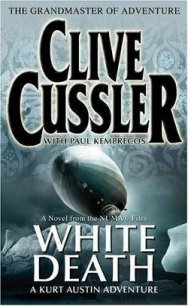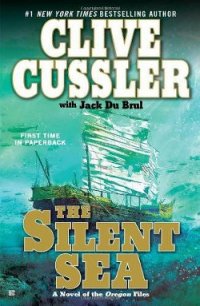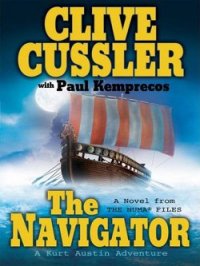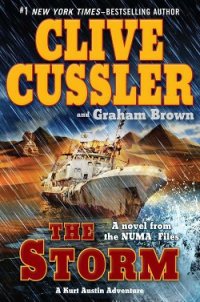Lost City - Cussler Clive (читать онлайн полную книгу .txt) 📗
Thurston apologized. "Sorry to recruit you as a Sherpa. We flew in supplies for the entire three weeks we're here, but we went through our from age and vin faster than we expected and used the occasion of your visit to bring in more stuff."
"Not a problem," Rawlins said with a good-natured grin, expertly adjusting the weight so it rode easily on his shoulders. "I used to jackass supplies to the White Mountain huts in New Hampshire before I became an ink-stained hack."
LeBlanc led the way along a path that rose for about a hundred yards through scraggly pines. Above the tree line the ground hardened into flat expanses of rock. The rock was sprayed with daubs of yellow spray paint to mark the trail. Before long, the trail became steeper and smoother where the rocks had been buffed by thousands of years of glacial activity. Water from runoff made the hard surface slick and treacherous to navigate. From time to time they crossed crevasses filled with wet snow.
The reporter was huffing and puffing with exertion and altitude.
He sighed with relief when they stopped at last on a shelf next to a wall of black rock that went up at an almost vertical angle. They were close to two thousand feet above the lake, which shimmered in the rays of the noonday sun. The glacier was out of sight around an escarpment, but Rawlins could feel the raw cold that it radiated, as if someone had left a refrigerator door open.
Thurston pointed to a round opening encased in concrete at the base of the vertical cliff. "Welcome to the Ice Palace."
"It looks like a drainage culvert," Rawlins said.
Thurston laughed and crouched low, ducking his head as he led the way into a corrugated metal tunnel about five feet in diameter. The others followed him in a stooping walk that was made necessary by their backpacks. The passage ended after about a hundred feet and opened into a dimly lit tunnel. The shiny wet orange walls of meta-mprphic rock were striped black with darker minerals.
Rawlins looked around in wonder. "You could drive a truck through this thing." "
With room to spare. "It's thirty feet high and thirty feet wide," Thurston said.
"Too bad you couldn't squeeze Fifi through that culvert," Rawlins said.
"We've thought of it. There's an entrance big enough for a car near the power plant, but Bernie is afraid she'd get beat up running around these tunnels."
"Fifi has a very delicate constitution," LeBlanc said with a snort.
The Frenchman opened a plastic locker set against a wall. He passed around rubber boots and hard hats with miners' lights on the crowns.
Minutes later, they set off into the tunnel, the scuffle of their boots echoing off the walls. As they plodded along, Rawlins squinted into the gloom beyond the reach of his headlamp. "Not exactly the Great White Way."
"The power company put the lighting in when they drilled through. A lot of those dead bulbs haven't been replaced."
"You've probably been asked this, but what brought you into glaciology?" Rawlins said.
"That's not the first time I've heard the question. People think glaciologists are a bit odd. We study huge, ancient, slow-moving masses of ice that take centuries to get anywhere. Hardly a job for a grown man, wouldn't you say, Bernie?"
"Maybe not, but I met a nice Eskimo girl once in the Yukon."
"Spoken like a true glaciologist," Thurston said. "We have in common a love of beauty and a desire to get outdoors. Many of us were seduced into this calling by our first awe-inspiring view of an ice field." He gestured around at the walls of the tunnel. "So it's ironic that we spend weeks at a time under the glacier, far from the sunlight, like a bunch of moles."
"Look what it has done to me," LeBlanc said. "Constant thirty-five degrees and one hundred percent humidity. I used to be tall and blond-haired, but I have shrunk and become a shaggy beast."
"You've been a short shaggy beast for as long as I've known you," Thurston said. "We're down here for three-week stints, and I agree that we do seem a bit mole like But even Bernie will agree that we're lucky. Most glaciologists only observe an ice field from above. We can walk right up and tickle its belly."
"What exactly is the nature of your experiments?" Rawlins asked.
"We're conducting a three-year study on how glaciers move and what they do to the rock they slide over. Hope you can make that sound more exciting when you write your article."
"It won't be too hard. With all the interest in global warming, glaciology has become a hot subject."
"So I hear. The recognition is long overdue. Glaciers are affected by climate, so they can tell us to within a few degrees what the temperature was on earth thousands of years ago. In addition, they trigger changes in the climate. Ah, here we are, Club Dormeur."
Four small buildings that looked like trailer homes sat end to end within a bay carved from the wall.
Thurston opened a door to the nearest structure. "All the comforts of home," he said. "Four bedrooms with room for eight researchers, kitchen, bath with shower. Normally, I've got a geologist and other scientists, but we're down to a skeleton crew consisting of Bernie, a young research assistant from Uppsala University and me. You can dump those supplies here. We're about a thirty-minute walk from the lab. We've got phone connections between the entrance, research tunnel and lab room. I'd better let the folks at the observatory know we're back."
He picked up a wall phone and said a few words. His smile turned into a puzzled frown.
"Say again." He listened intently. "Okay. We'll be right there."
"Is there anything wrong, professor?" LeBlanc said.
Thurston furrowed his brow. "I just talked to my research assistant. Incredible!"
"Qu'est-ce que c'est?" LeBlanc said.
Thurston had a stunned expression on his face. "He says he's found a man frozen in the ice."
TWO HUNDRED FEET below the surface of Lac du Dormeur in waters cold enough to kill an unprotected human, the glowing sphere floated above the gravelly bottom of the glacial lake like a will-o'-the-wisp in a Georgia swamp. Despite the hostile environment, the man and woman seated side by side inside the transparent acrylic cabin were as relaxed as loungers on a love seat. The man was husky in build, with shoulders like twin battering rams. Exposure to sea and sun had bronzed the rugged features that were bathed in the soft orange light from the instrument panel, and bleached the pale, prematurely steely gray hair almost to the color of platinum. With his chiseled profile and intense expression, Kurt Austin had the face of a warrior carved on a Roman victory column. But the flinty hardness that lay under the burnished features was softened by an easy smile, and the piercing coral-blue eyes sparkled with good humor.
Austin was the leader of NUMA's Special Assignments Team, created by former NUMA director Admiral James Sandecker, now vice president of the United States, for undersea missions that often took
place secretly outside the realm of government oversight. A marine engineer by education and experience, Austin had come to NUMA from the CIA, where he had worked for a little-known branch that specialized in underwater intelligence gathering.
After coming over to NUMA, Austin had assembled a team of experts that included Joe Zavala, a brilliant engineer specializing in underwater vehicles; Paul Trout, a deep-ocean geologist; and Trout's wife, Gamay Morgan-Trout, a highly skilled diver who had specialized in nautical archaeology before attaining her doctorate in marine biology. Working together, they had conducted many successful probes into strange and sinister enigmas on and under the world's oceans.




